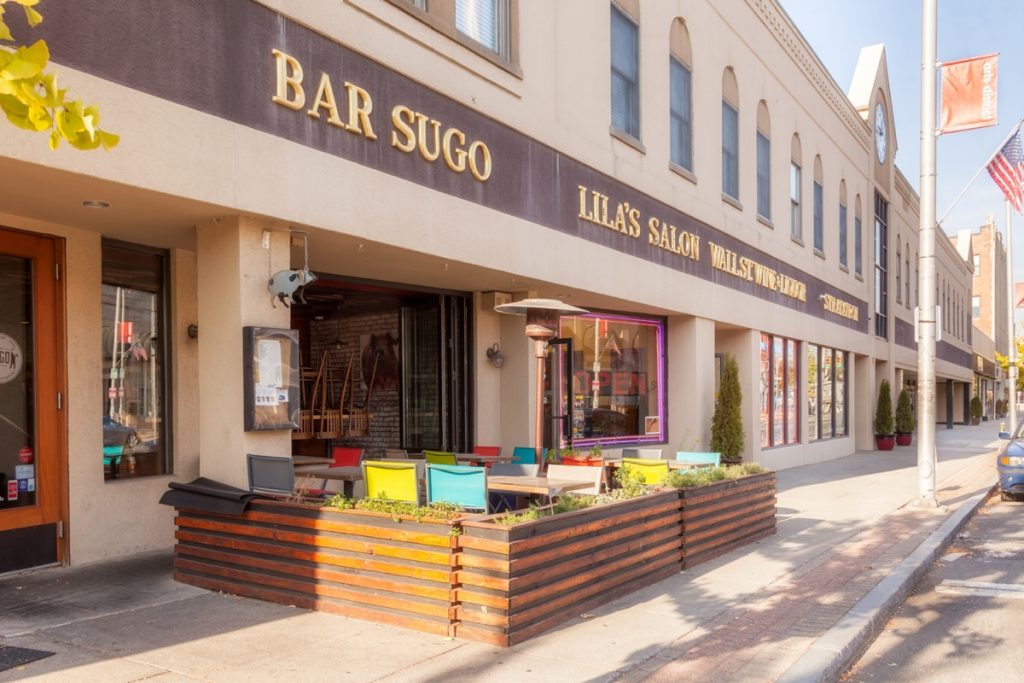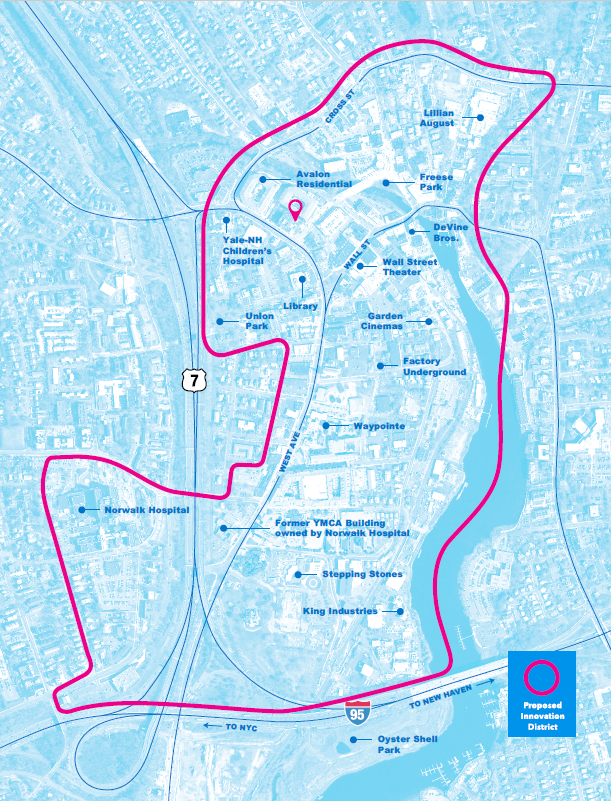March 23, 2018
 A new economic development strategy for cities is the urban innovation district. This holistic approach aims to revitalize underutilized parcels of city land by attracting both established companies and emerging entrepreneurs, and developing infrastructure and amenities to support them.
A new economic development strategy for cities is the urban innovation district. This holistic approach aims to revitalize underutilized parcels of city land by attracting both established companies and emerging entrepreneurs, and developing infrastructure and amenities to support them.
In 2017, Norwalk began to lay the groundwork for the Wall Street and West Avenue Corridor to become an Urban Innovation District. Below we discuss this strategy and why this area is ripe for such a transformation.
What Is An Innovation District?
An urban innovation district is a defined geographic area within a city where leading-edge tech companies and creative businesses and other “anchor” institutions such medical centers or research universities are clustered. Those businesses and institutions then connect with startups, incubators and accelerators (programs that support developing companies via mentorship, investors, etc.). An innovation district generally has many amenities, diversified housing opportunities, operates 24/7, and is hyper-connected via technology and transportation. Cities support these districts by providing tax incentives for infrastructure investment, real estate development, businesses, job creation and historic preservation.
Innovation Districts Across the Country
Innovation districts are emerging in many U.S. cities and metropolitan areas. Cities like Atlanta, Baltimore, Boston, Buffalo, Cleveland, Detroit, Philadelphia, Providence Pittsburgh, St. Louis, Seattle and San Diego have reshaped and revitalized underused, older industrial areas near anchor institutions. We look at two examples below.
Boston’s Seaport District
In 2010, Boston designated the Seaport District as an innovation district. Companies such as GE and Vertex received incentive packages for their moves into the district to create jobs and provide future tax revenues to fund public services. Since the innovation district’s establishment, more than 200 new businesses have moved in. The area has seen a growth of 4,000 jobs, and nearly doubled its residential population, adding more than 3,000 new residential units, 13% of which are required to be affordable. Future development in the Seaport District includes the addition of over 2,000 hotel rooms, 1.3 million square feet of office space, and more than 2,700 residential units.
Seattle’s South Lake Union
Seattle established an innovation district and incentive-zoning package in 2013 in South Lake Union area. A major developer built 5-million square feet of office, life sciences, residential and mixed-use projects in the neighborhood, which attracted Amazon to the district.
Since then, the South Lake Union area has attracted major bio and tech companies such as Fred Hutchinson Cancer Research Center, Seattle BioMed, Seattle Cancer Care Alliance, GroupHealth and PATH, adding more than 2,000 employees to the area. More than 50 new buildings have been constructed, and more than 1,400 new housing units have been added.
Why Does Norwalk Need an Innovation District?
Norwalk has a number of strong anchor institutions but has struggled to attract and retain synergistic companies that are incubators and accelerators in fields like health, technology, and science. If the city encourages the growth of a designated innovation district by providing incentives, these type of businesses will be drawn to the area, creating a cohesive and vibrant district made up of a variety of creative organizations and businesses and mixed-income employees and residents.
What makes an innovation district unique is not only the organizations and businesses, but also the people that work for them. The addition of certain creative businesses to Norwalk will build an environment of like-minded professionals who have multiple income levels interacting on a daily basis. These interactions will reactivate the Wall Street/West Avenue corridor and create a lively environment, transforming this area into a place with a strong identity and similar core values.
Why the Wall Street-West Avenue Area?
The area chosen to be an innovation district needs to have the foundation to support a vibrant and viable community. This foundation mainly comes from anchor institutions, available space, and amenities. The most crucial components are anchor institutions because they are well established and have the potential to draw other synergistic employers and businesses to the district.
The Wall Street-West Avenue area includes Norwalk Hospital, King Industries, Devine Brothers, Lillian August, Yale-New Haven Children’s Hospital, the Norwalk Main Library, and Stepping Stones Museum for Children. All of these institutions are major employers within the district. These businesses and organizations also have the potential to create collaborative relationships with one another around the themes of health, science, and technology.

Car-dependent, isolated, office parks in the suburbs are not where city planners and economic developers think the future of economic growth will be. Urban innovation districts can spur development and creativity via the melding of educational and research institutions, entrepreneurs and established businesses. Throw in mixed-use development (commercial, retail and housing together in one area) all connected by transit and technologically wired, and you have the potential for a bustling, vibrant area within a city. The Wall Street/West Avenue Corridor has many of those things already and may be poised to become an innovation district for Norwalk.




